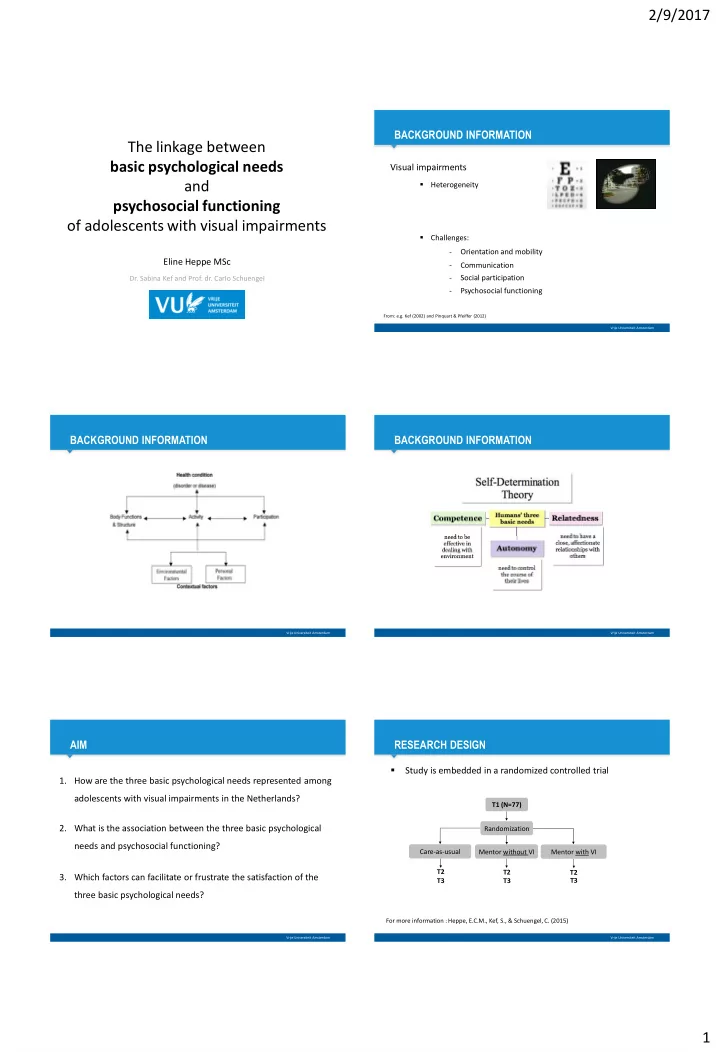

2/9/2017 BACKGROUND INFORMATION The linkage between basic psychological needs Visual impairments and Heterogeneity psychosocial functioning of adolescents with visual impairments Challenges: - Orientation and mobility Eline Heppe MSc - Communication - Social participation Dr. Sabina Kef and Prof. dr. Carlo Schuengel - Psychosocial functioning From: e.g. Kef (2002) and Pinquart & Pfeiffer (2012) Vrije Universiteit Amsterdam BACKGROUND INFORMATION BACKGROUND INFORMATION Vrije Universiteit Amsterdam Vrije Universiteit Amsterdam AIM RESEARCH DESIGN Study is embedded in a randomized controlled trial 1. How are the three basic psychological needs represented among adolescents with visual impairments in the Netherlands? T1 (N=77) 2. What is the association between the three basic psychological Randomization needs and psychosocial functioning? Care-as-usual Mentor without VI Mentor with VI T2 T2 T2 3. Which factors can facilitate or frustrate the satisfaction of the T3 T3 T3 three basic psychological needs? For more information : Heppe, E.C.M., Kef, S., & Schuengel, C. (2015) Vrije Universiteit Amsterdam Vrije Universiteit Amsterdam 1
2/9/2017 RESEARCH DESIGN METHOD Study is embedded in a randomized controlled trial Participants: N = 77 N Gender Age (year) Visual Impairment Male Female Min Max Mean Blind Severe Mild Baseline (T1) 77 T1 (N=77) measurement , 46% 54% 15 22 18 28% 33% 39% 2015 Randomization Computer Assisted Telephone interviews (CATI) Questionnaires: Care-as-usual Mentor without VI Mentor with VI Basic Psychological Need Satisfaction and Frustration scale (Chen et al., 2015) α = .74, . 78 and .79 T2 T2 T2 General well-being scale (Cantrill, 1965) T3 T3 T3 Rosenberg self-esteem scale (Rosenberg, 1965) α = .88 Loneliness Scale (De Jong Gierveld, 1999) α = .79 Nottingham Adjustment Scale (Dodds, 1991) α = .83 Perceived Stigmatization Scale (Ali et al., 2008) α = .79 For more information : Heppe, E.C.M., Kef, S., & Schuengel, C. (2015) Vrije Universiteit Amsterdam Vrije Universiteit Amsterdam RESULTS RESULTS Correlations between the three basic psychological needs and Means and standard deviations of need satisfaction among psychosocial functioning adolescents with and without visual impairments Well-being Loneliness Acceptance Self-esteem Stigmatization Competence Autonomy Impairment satisfaction satisfaction Competence Autonomy Relatedness Mean age N Loneliness -.55** 1 (range) Satisfaction Satisfaction Satisfaction .00 Adolescents with M SD M SD M SD 77 18 yr Acceptance .37** -.47** 1 visual impairment impairment .00 .00 , (15 -22) 3.87 .66 3.78* .66 4.28 .57 Self-esteem .56** -.49** .46** 1 * p < .05 .00 .00 .00 Competence Autonomy Relatedness Stigmatization -.27* .29* -.47** -.43** 1 Mean age N .02 .01 .00 .00 (range) Satisfaction Satisfaction Satisfaction Competence .59** -.44** .70** .67** -49** 1 Adolescents without M SD M SD M SD 200 20 yr Satisfaction .00 .00 .00 .00 .00 visual impairment a , (16 -32) 3.92 .64 3.57 .60 4.24 .59 Autonomy .46** -.39** .57** .43** -.41** .63** 1 Satisfaction .00 .00 .00 .00 .00 .00 a From: Chen et al. 2015 Relatedness .60** -.59** .53** .52** -47** .61** .63** .00 .00 .00 .00 .00 .00 .00 Satisfaction * p < .05, ** p < .001 Vrije Universiteit Amsterdam Vrije Universiteit Amsterdam RESULTS RESULTS Mediating models with psychosocial functioning and need Linear model of predictors of well-being with the three basic satisfaction predicting well-being psychological needs b SE B β p Constant -1.98 1.19 .10 Self-esteem Loneliness Relatedness Satisfaction 1.50 .39 .51 <.001 .31* -.59** -.30* .67* Competence Satisfaction 1.01 .35 .33 .002 Autonomy Satisfaction -.26 .33 -.10 .43 Competence Relationship .38* .42** Well-being Well-being satisfaction satisfaction R R Square Δ R Square Sig. F change p Model 1 .683 .467 .445 <.01 <.001 Model 2 .680 .463 .4448 .82 <.001 Note. Model 1 (constant), competence satisfaction, relatedness satisfaction, autonomy satisfaction Model 2 (constant), competence satisfaction, relatedness satisfaction Coefficients presented are standardized. * p < .05, ** p < .001 Vrije Universiteit Amsterdam Vrije Universiteit Amsterdam 2
2/9/2017 RESULTS CONCLUSION • No alarming scores of adolescents with visual impairments on Stigmatization predicting the three basic psychological needs through acceptance of the impairment satisfaction of the basic needs • Satisfaction of the basic needs are important predictors for well- Competence being, especially relationship and competence satisfaction satisfaction .70** • Psychosocial functioning is an important factor for the relation -.47** Acceptance of the Autonomy .55** stigmatization impairment satisfaction between satisfaction of the needs and well-being .53** Relatedness satisfaction • Feeling stigmatized can hinder the acceptance of the impairment, which is an important predictor for satisfaction of the three basic psychological needs Coefficients presented are standardized. Chi-square = 8.61 ( df = 3), CFI = .97, TLI = .90, SRMR = .07 ** p < .001 Vrije Universiteit Amsterdam Vrije Universiteit Amsterdam TAKE HOME MESSAGE ACKNOWLEDGEMENTS • Research team: Paying attention to satisfaction of the three basic psychological needs and a positive and tolerant social climate among adolescents with visual impairment is important and could be used as a tool to Eline Heppe, MSc Dr. Sabina Kef Prof. dr. Carlo Schuengel enhance well-being, self-determination, and psychosocial • Funders: functioning Contact information: e.c.m.heppe@vu.nl Vrije Universiteit Amsterdam Vrije Universiteit Amsterdam 3
Recommend
More recommend